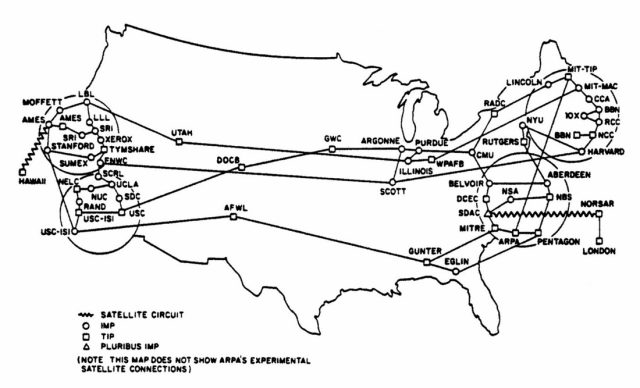
On October 29, 1969, at 10:30pm Pacific Time, the primary two letters had been transmitted over ARPANET. After which it crashed. About an hour later, after some debugging, the very first distant connection between two computer systems was established over what would sometime evolve into the trendy Web.
Funded by the Superior Analysis Tasks Company (the predecessor of DARPA), ARPANET was constructed to discover applied sciences associated to constructing a navy command and management community that might survive a nuclear assault. However as Charles Herzfeld, the ARPA Director who would oversee many of the preliminary work to construct ARPANET put it:
The ARPANET was not began to create a Command and Management System that might survive a nuclear assault, as many now declare. To construct such a system was, clearly, a significant navy want, however it was not ARPA's mission to do that; in actual fact, we'd have been severely criticized had we tried. Somewhat, the ARPANET got here out of our frustration that there have been solely a restricted variety of massive, highly effective analysis computer systems within the nation, and that many analysis investigators, who ought to have entry to them, had been geographically separated from them.
In its infancy, ARPANET had however 4 "nodes":
- The College of California-Los Angeles' Community Measurement Heart, with its SDS Sigma 7 laptop;
- Stanford Analysis Institute's Community Data Heart, with its SDS 940 laptop operating NLS (an early hypertext system and precursor to the World Extensive Net);
- The College of California, Santa Barbara's Culler-Fried Interactive Arithmetic Heart, with its IBM 360/75 operating OS/MVT; and
- The College of Utah College of Computing, with its Digital Tools Corp PDP-10 operating the TENEX working system.
Somewhat than being instantly linked, the computer systems had been linked by way of Interface Message Processors (IMPs), which had been the primary community routers. This is able to enable extra methods to be added as nodes to the community at every web site because it advanced and grew. This concept got here from physicist Wesley Clark, who can also be credited with designing the LINC, the world's first private laptop.
The primary letters transmitted, despatched from UCLA to Stanford by UCLA scholar programmer Charley Kline, had been "l" and "o." On the second try, the complete message textual content, login, went by way of from the Sigma 7 to the 940. So, the primary three characters ever transmitted over the precursor to the Web had been L, O, and L.
By the point I used to be first uncovered to ARPANET, it had grown considerably, however it was nonetheless primarily a connection between researchers and navy organizations. ARPANET was operated by the navy till 1990, and till then, utilizing the community for something apart from government-related enterprise and analysis was unlawful. By that point, ARPANET was largely being supplanted by the Nationwide Science Basis Community (NSFnet). Though the Protection Division had break up off its personal networks as MILNET within the mid 1980s, components of the navy nonetheless referred to its community connections as ARPANET in lots of inner paperwork into the early 1990s, as I discovered once I was working as a community engineering contractor at Military Check Lab at Aberdeen in 1992.

When it was shut down, Vinton Cerf, one of many fathers of the trendy Web, wrote a poem in ARPANET's honor:
It was the primary, and being first, was finest,
however now we lay it all the way down to ever relaxation.
Now pause with me a second, shed some tears.
For auld lang syne, for love, for years and years
of devoted service, responsibility performed, I weep.
Lay down thy packet, now, O pal, and sleep.
With out ARPANET, there would have been no Web. So pour one out for the unique tonight when you occur to be basking within the Web's glow.
